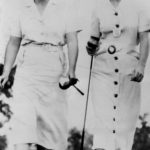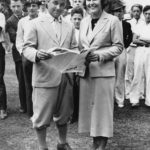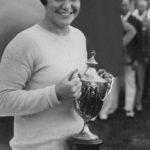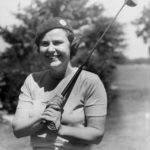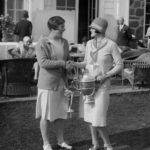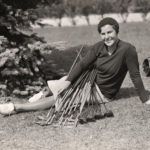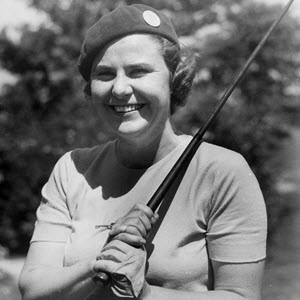
Helen Hicks (2022)
About Helen Hicks (2022)
Despite not learning the game until the age of 15, Helen Hicks of Cedarhurst, Long Island, became such a skilled golfer she earned a spot on the Lawrence High School team. It was the late 1920s, and the squad previously consisted of all boys—still the case with rival schools. Though Hicks’s teammates accepted her, she “got no quarter” from opponents, reported the Brooklyn Daily Eagle, adding that schools often matched their best player against her and she received “some real trouncings.”
Rather than discourage her, the experience emboldened Hicks—and became emblematic of her trailblazing career. Not only did Hicks go on to become the women’s national amateur champion, she signed an endorsement deal with Wilson Sporting Goods in 1934 that sent her around the country and overseas giving clinics and effectively made her the first professional woman golfer in America. As if those milestones weren’t enough, Hicks later joined 12 other women in founding the LPGA, establishing the permanent tournament circuit for women pros that was lacking in her day.
Variously described in the press as a “sturdy broad-shouldered young lady,” the “Eastern slugger,” and “hard-hitting Helen Hicks,” she captured her first notable victory at age 18, the Canadian Women’s Open Amateur in 1929. Two years later, she won the U.S. Women’s Amateur — the women’s national championship since there was no professional Tour. In the final 36-hole match at the Country Club of Buffalo, Hicks defeated the three-time defending champion Glenna Collett Vare, who had won the event the previous three times, 2 & 1.
Along with Vare, Maureen Orcutt, and Virginia Van Wie, Hicks was part of what was known as the Big Four of women’s amateur golf. In 1932 she joined them and others in representing the United States in the inaugural Curtis Cup, competing against Great Britain at Wentworth Golf Club in England. The American team, which won the matches, was captained by Marion Hollins, another path-breaking figure in the history of American golf (and fellow member of the MGA Hall of Merit, as is Orcutt).
Hicks continued to compete in amateur events, reaching the finals of the U.S. Women’s Am once again in 1933, this time losing to Van Wie. She became known for both her power off the tee and an engaging personality that drew people to her. “Debonair, blithe, happy-go-lucky and fearless,” Vare wrote of Hicks, “she enters into everything she undertakes with the same splendid, joyous spirit.”
In 1934 Hicks began making public appearances, including, as recounted by Rhonda Glenn in a USGA.org feature titled “On the Early Road with Helen Hicks,” entertaining foreign dignitaries and charming New York magazine editors into assigning her articles to write.
Impressed by Hicks’s magnetism, Lawrence Icely, president of Wilson Sporting Goods, came up with the idea of signing her to a contract and sending her around the country to give clinics and promote a line of women’s golf clubs bearing her name. Hicks seized the opportunity, eagerly going out on the road while also continuing her competitive career. In doing so, she became the first woman to earn a living playing golf.
As part of her ambassadorial role, Hicks would barnstorm with Gene Sarazen, another Wilson endorser and Met Area native, including a tour of Australia and New Zealand in 1936. The two of them partnered in four-ball matches, occasionally against another male-female pair but typically versus the two finest players of whichever club they happened to be visiting that day.
“I don’t believe we were defeated more than three times in our 62 matches, so you can judge for yourself the brand of golf that Helen was playing,” Sarazen wrote in his autobiography, Thirty Years of Championship Golf. “Her naturalness and affability captivated the galleries wherever we went and made our exhibition tour just about the most continually pleasant one I have ever undertaken.”
Her responsibilities for Wilson notwithstanding, Hicks continued to excel at the top echelon of women’s golf. Referred to as a “businesswoman golfer,” she won two tournaments now recognized as major championships, the Women’s Western Open (1937) and the Titleholders (1940).
Seeking to build on its success with Hicks, Wilson signed more women golfers to endorsement deals. Their ranks included Opal Hill, Helen Dettweiler, and, beginning in 1940, Patty Berg, who had watched admiringly as Hicks put on clinics and who would go on to give thousands of them herself.
In 1938, Hicks married a widower named Whitney Harb, an auto agency owner in North Little Rock, Ark., who was 18 years her senior. She became a widow herself when he died in 1948. At about that time, she started working behind the scenes to establish a new pro tour to supplant the faltering Women’s Professional Golf Association, which had been founded in 1944. In 1950, she was one of 13 women to launch the LPGA.
By time of her death in 1974, Hicks had seen the LPGA and, more broadly, women’s golf blossom with the emergence of stars such as Berg, Babe Didrikson Zaharias, Louise Suggs, Mickey Wright, and Kathy Whitworth—all following, and thriving in, her pioneering path.
A True Pioneer in the Game …
Hicks had a trailblazing career as the women’s national amateur champion, traveled all over the world with Wilson Sporting Goods, and later joined 12 other women in founding the LPGA.
ADDITIONAL DETAILS & MULTIMEDIA
Life Events
- Date of Birth: February 11, 1911
- Date of Death: December 16, 1974 (Age 63)
- Year Turned Professional: 1934 (Age 23 )
- Hometown: Cedarhurst, New York
Achievements
- Won the Canadian Women’s Open Amateur in 1929 at the age of 18
- Won the U.S. Women’s Amateur — the women’s national championship since there was no professional Tour
- Competed on and won the inaugural Curtis Cup, competing against Great Britain at Wentworth Golf Club in England
- Two time major champion the Women’s Western Open (1937) and the Titleholders (1940)
- One of 13 women to launch the LPGA

